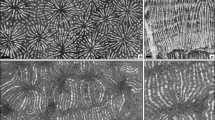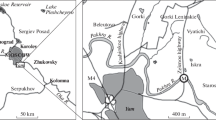Abstract
It has been suggested that septal furrows in the Palaeozoic rugose corals are secondary in comparison both to growth lines and to the septal blades inside calices. The leading role of furrows as an indicator of septal increase is thus questioned. Septa are always grouped in quadrants but their increase is generally towards the cardinal septum. The arrangement of the contratingent minor septa seems to be independent of the increase in septal furrows. Hence, the growth of the polyp's skeleton may have started from an aseptal cup.
Similar content being viewed by others
References
Duerden, J. E., 1902. Relationships of the Rugosa (Tetracoralla) to the living Zoantheae. Ann. Mag. nat. Hist. (Ser. 7) 9: 381–398.
Fedorowski, J., 1987. Upper Palaeozoic rugose corals from southwestern Texas and adjacent areas: Gaptank Formation and Wolfcampian corals. Part 1. Palaeont. Pol. 48: 1–271.
Hill, D., 1981. Part F Coelenterata, Supplement 1 Rugosa and Tabulata. In C. Teichert (ed.), Treatise on Invertebrate Paleontology 1,2. Geol. Soc. Amer.; Univ. Kansas, Lawrence: F1-F762.
Hudson, R. G. S., 1936. The development and septal notation of the Zoantharia Rugosa (Tetracoralla). Proc. Yorks. geol. Soc. 23: 68–78.
Ivanovskii, A. B., 1972. Vnutrividovaya izmenchivost, morfologiya i ontogenez skeleta Calophyllum profundum (Rugosa) po materialam iz Kazanskogo yarusa Russkoy platformy. Trudy Inst. Geol. Geofiz. sib. Otd. 112: 4–9.
Kunth, A., 1869. Beiträge zur Kenntnis fossiler Korallen, 2. Das Wachstumsgesetz der Zoantharia Rugosa und über Calceola sandalina. Z. dt. geol. Ges. 21: 647–688.
Oliver, W. A., 1980. The relationship of the scleractinian corals to the rugose corals. Paleobiology 6: 146–160.
Sando, W. J., 1961. Morphology and ontogeny of Ankhelasma, a new Mississippian coral genus. J. Paleont. 35: 65–81.
Schouppé, A. & P. Stacul, 1955. Die Genera Verbeekiella Penecke, Timorphyllum Gerth, Wannerophyllum gen. n., Lophophyllidium Grabau aus dem Perm von Timor. Palaeontographica, Abt. A, Suppl. Bd 4, Pt 5, No 3: 95–196.
Vollbrecht, E., 1928. Die Entwicklung des Septalapparates bei Semaiophyllum: ein Beitrag zur Entwicklung des Septalapparates der Rugosen. Neues Jb. Miner. Geol. Paläont. BeilBd 59 (B): 1–30.
Weyer, D., 1974. Das Rugosa-Genus Antiphyllum Schindewolf, 1952 (Unternamur Oberschlesisches Steinkhlenbecken). Čas. Miner. Geol. 19: 345–365.
Wright, A. J., 1969. Notes on tetracoral morphology. J. Paleont. 43: 1232–1236.
Yü, C. C., 1963. O svyazi roda Cystophrentis s shestiluchevymi korallami i ustanovlenie otryada Mesocorallia Yü ord. nov. i semeystva Cystophrentidae Yür fam. nov. Acta Palaeont. sin. 11: 307–318. (Chinese, Russian trans.)
Author information
Authors and Affiliations
Rights and permissions
About this article
Cite this article
Fedorowski, J. Principles of early ontogeny in the rugose corals: a critical review. Hydrobiologia 216, 413–418 (1991). https://doi.org/10.1007/BF00026494
Issue Date:
DOI: https://doi.org/10.1007/BF00026494




